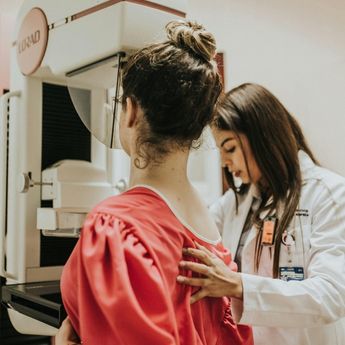By Adriana Ermter
In our monthly column, senior writer and editor Adriana Ermter shares her personal experiences with breast cancer.
I was diagnosed with early-stage breast cancer. Ironically, considering we live in a world inundated with cancer walks and runs, cancer awareness foundations, cancer fundraisers, and the undeniable fact that we’re all a mere six degrees of separation from someone dealing with cancer, I had no idea what this meant. Literally and personally, regarding both my immediate health, my future wellbeing, and my life. Hearing my cancer diagnosis was harsh. I didn’t know how to respond. Its impact ranked even higher on my personal emotional scale than when my now ex-husband told me he didn’t love me anymore. When that happened, I responded immediately, ugly crying for months on end. Yet, when I was told that I had cancer, my mind, heart, and emotions, especially all of my feelings of hope, completely shut down and everything around me turned into white noise.
As I tried to process my diagnosis and what it meant for me, along with the future I’d envisioned for myself, I went into research mode. It’s my comfort zone. I’m curious by nature and profession (being a writer and all), and having information, knowing everything that I need to know, makes me feel in control. So, I dug deep, Googled like a crazed person, and asked my doctors hundreds of questions while I tried as best as I could to prepare myself for the unknown that was to come. Here’s what I learned about being diagnosed with early-stage breast cancer.
Defining early-stage breast cancer
Breast cancer diagnoses have two important qualifiers: the stage of the breast cancer and the grade of it. Early-stage typically means that the cancer is localized to one area, most likely the breast, although in my case my lump was in my right armpit with a tail that trailed into my breast. It also means that it has not spread beyond the breast and into other parts of the body through the bloodstream or lymphatic system. Early-stage breast cancer is typically categorized as either stage 0, stage I, or stage II, depending on the size of the tumour.
Size does matter
The size of the tumour plays into the stage of the cancer, because it is an important factor in determining the stage of the disease. Size also helps identify what type of treatment, such as surgery, radiation, chemotherapy and tamoxifen etc., that you will need. In general, smaller tumours are associated with an earlier stage of breast cancer and can have a better outcome. Larger tumours tend to indicate a more advanced stage of the disease and can have a higher risk of recurrence or metastasis, which is when the cancer spreads through the lymphatic system to other parts of the body.
It's also good to know that when the oncology doctors talk about the size of your tumour, they’re referring to its dimensions, which are usually measured in inches, centimeters, or millimeters. This then indicates how large the cancerous growth is within the breast tissue. This sounds straightforward and it sort of is, because the measurements help make it easier to imagine what the tumour looks like. You can literally pull out a ruler or a measuring tape and draw it on a piece of paper. I know because I did that. My drawing looked like a large pea and in an odd way made my cancer more relatable for me.
Where things got a little murky, however, was when my doctors talked about the diameter of my tumour. This concept felt really abstract and I couldn’t draw it out or envision it, which made it harder for me to care about. Turns out, knowing your tumour’s diameter measurement is pretty important, though. It refers to the distance across the widest part of the tumour and this measurement helps classify the tumour as being either small, medium, or large. It also provides valuable information about the extent of the cancer and its potential to grow and spread.
Early detection can be a good thing, but…
While my doctors were able to share most of this theoretical information with me prior to my surgery, the tumour’s actual measurements were confirmed post-surgery, once it had been removed from my body. These facts took a while to absorb, so I didn’t openly share this information with anyone beyond the tight circle of family and friends I confided in. When I was ready to speak openly about my diagnosis and share the stage and grade of my cancer with others, many, including a handful of relatives quickly dismissed me saying things like, “you’re so lucky,” or “so you barely even have cancer then” or “well, this will be super easy.” It’s wild that people feel comfortable saying such crappy things, but they do. Maybe they said these things in attempt to make me feel better. I’m not sure. All I know is that I did not feel lucky to have cancer, regardless of its stage. I also didn’t feel sorry for myself, and not once did I think: why me?
According to the Canadian Cancer Society, one in every eight women will be like me and diagnosed with breast cancer in their lifetime. Also like me, 50 per cent of these women will not have a familial history. Even if they are diagnosed early. Still, the Government of Canada states that one in 34 women will die from the disease each year, regardless of the stage of their breast cancer. Early detection does not guarantee that you’ll have a stage one cancer or that you will live. It does, however, increase the likelihood of both.
That’s why it’s important to know that even within the early stages of breast cancer, there can be variations in prognosis and treatment outcomes depending on factors such as, tumour biology, hormone receptor status, HER2 status, and individual patient characteristics. While many women with stage one breast cancer have excellent long-term survival rates, some may experience disease recurrence or progression despite early detection and treatment. The tough reality is that breast cancer is complex with various subtypes and biological behaviours. Some aggressive forms can progress rapidly even when they are detected early. But! And this is a big one, early detection does mean that doctors can attend to your health immediately with timely interventions and treatments when the cancer is most treatable.
So, what’s your role in early detection?
Do monthly breast self-exams. Based on a 2017 study by The American College of Obstetricians and Gynecologists, approximately 50 per cent of cases of breast cancer in women who were 50 years and older, and 71 per cent of cases in women who were younger than 50 years, were detected by the women themselves. That means that these women found their lumps on their own and then went to a healthcare specialist for confirmation. Puts the importance of doing a monthly breast self-exam into perspective doesn’t it?
Pre breast cancer, I almost never checked myself for lumps. I did find my tumour though, on happenstance while lathering up in the shower. And thank God I did. Now, post breast cancer, I’m religious about looking at and feeling my boobs. I look at them naked in the mirror and physically check them for any abnormalities on the first day of every month. Regular self-examinations, combined with screenings through annual mammograms and prompt reporting of any concerning symptoms to your general practitioner are essential for maximizing the benefits of early detection and optimizing your survival chances should you be like me and find a lump. Anyone, regardless of age, race, or gender, can develop early-stage breast cancer despite the disease being most commonly diagnosed in women over the age of 50.
The five signs and symptoms of early-stage breast cancer
While no two breast cancers are alike, there are five signs and symptoms to be on the lookout for. And all you have to do to identify them is stare at your naked boobs in the mirror and conduct a breast self-exam once a month. Here’s what to look for:
- You feel a lump or a hard mass of tissue
This is the most common symptom of cancer in your breast or underarm area. These masses are usually painless, but they can sometimes be tender when you touch them. - Your breast looks or feels different
Has one of your boobs changed in size or shape? Early-stage breast cancer can cause your breast to become larger or to droop or drop a little lower than the other. It can also change the shape or contour of your breast. - Your breast’s skin looks different
Cancer can change the way your skin looks and feels. Redness, dimpling, puckering or thickening of the breast tissue can indicate the presence of breast cancer. - Your nipple looks different
Has the appearance of your nipple changed? Maybe it has inverted or perhaps there is scaling on the area or maybe you see a discharge that is not breast milk. - You experience breast pain
This isn’t a common symptom of breast cancer, but it can be an indicator. If you feel an unusual or persistent pain in one or both or your breasts or in your underarm areas, book an appointment with your doctor and have it checked out.
How to be proactive about your breast health
You will always be your best advocate for your health. When and if something feels off, talk about it, get it looked at by a doctor and be persistent about getting the support and treatment you need. It’s your body and only you can take care of it.
Ask for routine, annual mammograms, especially if you are 40 years and older. These screenings can often detect tumours that are too small to be felt during a physical examination, enabling early intervention and treatment. If you’re like me, you may need further imaging tests such as ultrasounds or MRIs. If something suspicious is seen on these tests, a biopsy may be needed to obtain a sample of the tissue for examination under a microscope. Screening is crucial for your health, because the earlier the cancer is detected, the more likely it is to be treatable and with less invasive methods, so that you can have a better prognosis overall.
Early detection can also lead to significant cost savings for you, our healthcare system, and even for other women who will be diagnosed in the future. That’s because treating breast cancer at an early stage is generally less expensive than managing advanced-stage disease, which can require more intensive treatments, hospitalization and supportive care services. Additionally, when you, your general practitioner and breast cancer clinics invest in early detection efforts, our healthcare system can reduce the financial burden of breast cancer care and allocate resources more efficiently to benefit a greater number of patients. Plus, when you take the lead in your own health care, you will feel more in control of your diagnosis and your life.
Adriana Ermter is a multi award-winning writer and editor. Her work can be read in Sotheby’s Insight, Living Luxe and IN Magazine, as well as online at 29Secrets.com, RethinkBreastCancer.ca, Popsugar.com and AmongMen.com. The former Beauty Director for FASHION and Editor-in-Chief for Salon and Childview magazines lives in Toronto with her two very spoiled rescue cats, Murphy and Olive. You can follow Adriana on Instagram @AdrianaErmter







